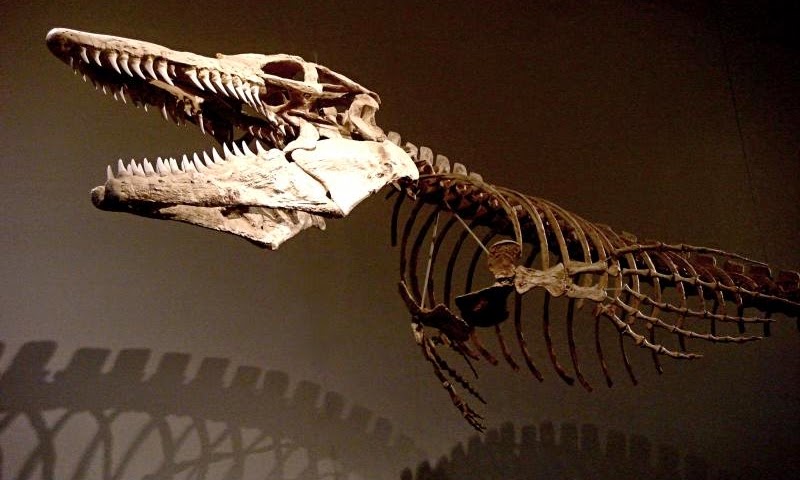
A new study has helped settle the controversial relationships among the major groups of lizards and snakes, and it sheds light on the origins of a group of giant fossil lizards.
Squamate reptiles—lizards and snakes—are among the most diverse groups of vertebrates, with more than 9,000 living species. They are important for humans because venomous snakes cause tens of thousands of deaths every year. At the same time, their toxins are a critical resource for many medicines, including those for heart disease and diabetes. Lizards and snakes also are important model systems for biological research, especially in ecology and evolutionary biology.
Unfortunately, studies of squamate biology have been hampered by controversy over their evolutionary relationships, and some researchers consider their family tree to be unresolved. The problem is that studies based on traditional, anatomical characters and those based on molecular data from DNA sequences have strongly disagreed, especially on how the iguanas and their relatives (called iguanians) are related to snakes and to other groups of lizards. Iguanians include horned lizards, flying dragons and basilisks.
A new study by scientists from the University of Arizona, San Diego State University, the Smithsonian Institution, Brigham Young University and the University of Mississippi has now helped to resolve this controversy, and it also offers new insights on the evolution of fossil lizards. The results are published online in the journal PLoS One.
“Anatomical data put iguanians at the base of the tree, whereas molecular data suggest that the iguanians evolved more recently and are closely related to snakes and a group including the monitor and alligator lizards, called the anguimorphs,” said John J. Wiens, a professor in the Department of Ecology and Evolutionary Biology in the UA College of Science. “The results of our study overwhelmingly support the molecular hypothesis.”
The team assembled the largest-yet datasets of both anatomical and molecular characters for the major groups of lizards and snakes. The researchers showed that when the anatomical and molecular data are combined, the results conclusively support the molecular hypothesis, placing iguanas and relatives with snakes and anguimorphs.
One possible explanation for these results is the greater number of molecular characters relative to morphological characters (35,673 molecular versus 691 morphological). This larger number might favor the molecular hypothesis, regardless of which hypothesis is actually true. To test this idea, the researchers trimmed the molecular dataset to only 63 characters. When they analyzed this reduced molecular dataset with all 691 anatomical characters, the results still supported the molecular hypothesis, placing iguanians with snakes and anguimorphs instead of at the base of the tree.
Wiens’ team also found that there was support for the molecular hypothesis hidden in the morphological dataset. When the researchers combined the molecular and morphological data, they found that the number of morphological characters that supported the branch uniting iguanians, snakes and anguimorphs (the molecular hypothesis) was almost equal to the number placing iguanians near the base of the tree (the morphological hypothesis).
In addition, the researchers found that when they divided up the anatomical characters and analyzed each set separately, only one of the six sets clearly supported the morphological hypothesis.
“In fact, the morphological data are really ambiguous,” Wiens said. “Or in some cases, even worse than ambiguous.”
He explained that the morphological data give very strange, non-traditional relationships in which all burrowing species are placed together, including those classified in different families.
“Basically, burrowing lizards tend to evolve elongate bodies, reduced limbs and a whole suite of other anatomical traits, even if they are only distantly related to each other,” Wiens said. “Placing all burrowing species together disagrees strongly with the molecular data, and also with traditional taxonomy. In summary, the anatomical data can be widely misleading in squamate reptiles.”
Wiens and co-authors suggest a similar explanation for why the anatomical data are misleading about the placement of iguanians in particular.
According to Wiens, iguanian lizards typically capture prey using their tongue, whereas snakes and other lizards use their jaws. Scientists have documented many differences in diet, behavior and anatomy that seem to be associated with capturing prey with the tongue versus the jaw. It turns out that the closest living relative to lizards and snakes, the tuatara of New Zealand, also uses its tongue to capture prey. Therefore, the anatomical characters that place iguanians at the base of the tree may reflect parallel evolution associated with these different feedings modes.
The study also has implications for understanding the evolution of fossil lizards, such as mosasaurs, as well. These carnivorous marine lizards, which died out with the dinosaurs around 65 million years ago, have traditionally been thought to either be close relatives of monitor lizards, or close to the base of the squamate family tree. The new study combined data from both living and fossil species and revealed mosasaurs to be close relatives of snakes, and only distantly related to monitor lizards and species at the base of the tree.
“What is really interesting about this is that we have no molecular data for mosasaurs at all,” Wiens said. “Our results show how combining molecular and anatomical data can reveal evolutionary relationships of fossil species that one might not predict from the anatomical data alone.”
Reference:
“Integrated Analyses Resolve Conflicts over Squamate Reptile Phylogeny and Reveal Unexpected Placements for Fossil Taxa.” PLoS ONE 10(3): e0118199. DOI: 10.1371/journal.pone.0118199
Note : The above story is based on materials provided by University of Arizona.










